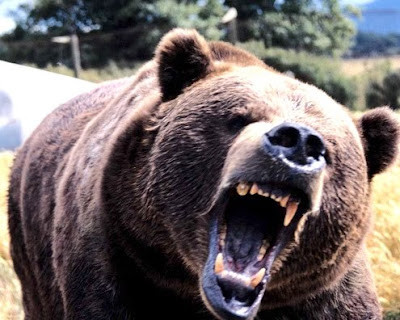People in Vermont's Northeast Kingdom were supposedly harassed by such a creature in the 1700s. The Wabanaki Indians called him Wejuk or "wet skin" because he always slipped away when they tried to capture him. Following the Wabanaki lead the the English settlers called him Slipperyskin.
Slipperyskin caused a lot of trouble. He knocked over fences, terrorized livestock, and ruined cornfields. Those are probably things any ordinary bear might do, but Slipperyskin was no ordinary bear. He was a very intelligent and tricky bear, so he also put rocks into maple syrup buckets and farm machinery. He once rolled a log at hunters who were chasing hime. He even threw stones at small children walking to school. Bears don't have opposable thumbs so I'm not sure how he accomplished this.
It was pretty obvious Slipperyskin didn't like humans. The feeling was mutual and many attempts were made to catch or kill the pesky bear. None were ever successful but at least one was quite humorous. In the early 1800s Vermont governor Jonas Galusha came up with a scheme to trap Slipperyskin. The governor doused himself with female bear scent and walked into the woods, hoping to lure Slipperyskin into a clearing where hunters waited with rifles. Mere minutes after heading into the woods the governor ran into the clearing chased by an amorous Slipperyskin. The hunters fled in panic at the sight of the giant lustful bear. Governor Galusha escaped with his life but sustained severe damage to his dignity.
Although he was quite a terror Slipperyskin never killed anyone but he was once accused of eating a minister. One day a group of ministers were picnicking on the shores of Westmore's Lake Willoughby when the bear emerged from the bushes with a furious roar. The holy men fled in all directions as the ursine horror attacked their picnic lunch.
After Slipperyskin departed they returned to the picnic ground. All of the ministers were present expect one. The ministers looked with dread upon the picnic blanket where a mass of torn clothes and amorphous biological matter hinted at the grim fate of their missing companion. It was clear the bear had killed and devoured him. However, closer examination later showed the disgusting mess to be half-eaten cheese and not a human corpse. Their missing companion was later found alive and well. Under the cover of the bear attack he had secretly fled an unhappy life in Vermont and set up a new one in Chicopee, Massachusetts.
Vermonters stopped seeing Slipperyskin in the early 1800s but his legend lives on. Some of the stories about him, like those with the governor and the ministers, are pretty humorous and I wonder how seriously we're supposed to take the stories about this clever and infuriating bear. Was he even real? After all, bears don't normally do the things Slipperyskin did.
Some Bigfoot researchers think the stories are really garbled accounts of Sasquatch encounters but I'm not entirely convinced. I think the Wabanaki would be able to reliably identify a bear, as would the English frontiersmen who were settling in Vermont. And besides, does it make sense to explain away a legendary bear with a legendary hairy humanoid?
There's a big chance Slipperyskin might just be a tall-tale people told to amuse each other. Still, folks in New England have been encountering weird things in the woods for centuries, and often those weird things throw rocks and cause mischief. They ruin farm machinery and cause trouble in bars. At different times people have called them witches, demons, poltergeists, Bigfoot, or even Slipperyskin. Maybe they're all just different manifestations of some strange phenomenon associated with this corner of the country.
Think of it this way. Perhaps Slipperyskin was just one manifestation of the New England genius loci, which is a Latin term meaning "spirit of a place." Maybe this clever bear was just a particularly cranky version of the spirit of this stony and wooded corner of the country. Then again, does it make sense to explain away a legendary Vermont bear with a concept from ancient Roman religion? Maybe not but it's interesting to consider.
*****
I first learned about Slipperyskin in books by Vermont's Joseph Citro. A great source of information about him is this article in The Northland Journal.

